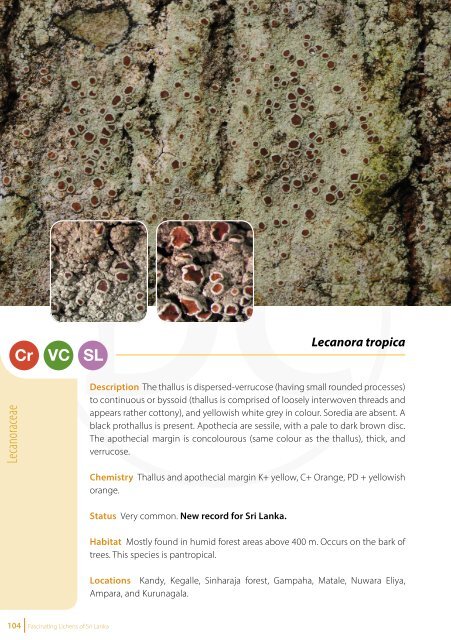Create successful ePaper yourself
Turn your PDF publications into a flip-book with our unique Google optimized e-Paper software.
Leioderma<br />
Treepelt lichen, Mouse ears<br />
Peltigerales Pannariaceae<br />
c.10<br />
Leioderma is mainly found in the Southern Hemisphere. It is extremely rare in the<br />
Northern Hemisphere and is only known to occur in a few localities. It is a small<br />
genus. Most species are epiphytes found on shrubs and trees. They are restricted<br />
to moist habitats and found in undisturbed conditions at the scrubby margins <strong>of</strong><br />
montane forests in <strong>Sri</strong> <strong>Lanka</strong>.<br />
Thus far, only one species, Leioderma sorediatum has been found in <strong>Sri</strong> <strong>Lanka</strong>.<br />
Namely, in Horton Plains and a few adjacent localities, a few places in Nuwara<br />
Eliya, Kalupahana and the Knuckles Peak <strong>of</strong> the Knuckles mountain range. The<br />
distribution known so far demonstrates that this genus is confined to high<br />
elevation montane forests.<br />
Cr<br />
VC<br />
SL<br />
Lecanora tropica<br />
This species is corticolous in <strong>Sri</strong> <strong>Lanka</strong>. The thallus is foliose and has loosely<br />
attached rosettes. This small genus is mostly related to Pannaria and Parmeliella.<br />
It is probably most similar to Erioderma sorediatum (an extremely rare species in<br />
<strong>Sri</strong> <strong>Lanka</strong>), but has longer lobes, is paler grey, and has many more tufted rhizines<br />
on the lower surface. It is possible that more species could occur in the highlands<br />
in montane communities which have not yet been observed.<br />
Lecanoraceae<br />
Description The thallus is dispersed-verrucose (having small rounded processes)<br />
to continuous or byssoid (thallus is comprised <strong>of</strong> loosely interwoven threads and<br />
appears rather cottony), and yellowish white grey in colour. Soredia are absent. A<br />
black prothallus is present. Apothecia are sessile, with a pale to dark brown disc.<br />
The apothecial margin is concolourous (same colour as the thallus), thick, and<br />
verrucose.<br />
Apothecia round, biatorine, disc pale to red brown; Asci: 8-spored; Spores:<br />
colourless, and simple.<br />
Chemistry hymenium I+ persistent blue (except one species in the genus)<br />
Pannariaceae<br />
Chemistry Thallus and apothecial margin K+ yellow, C+ Orange, PD + yellowish<br />
orange.<br />
Status Very common. New record for <strong>Sri</strong> <strong>Lanka</strong>.<br />
Habitat Mostly found in humid forest areas above 400 m. Occurs on the bark <strong>of</strong><br />
trees. This species is pantropical.<br />
Locations Kandy, Kegalle, Sinharaja forest, Gampaha, Matale, Nuwara Eliya,<br />
Ampara, and Kurunagala.<br />
104 <strong>Fascinating</strong> <strong>Lichens</strong> <strong>of</strong> <strong>Sri</strong> <strong>Lanka</strong><br />
<strong>Fascinating</strong> <strong>Lichens</strong> <strong>of</strong> <strong>Sri</strong> <strong>Lanka</strong> 105















